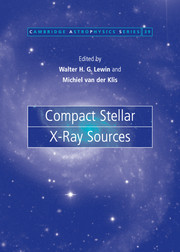Book contents
- Frontmatter
- Contents
- List of contributors
- Preface
- 1 Accreting neutron stars and black holes: a decade of discoveries
- 2 Rapid X-ray variability
- 3 New views of thermonuclear bursts
- 4 Black hole binaries
- 5 Optical, ultraviolet and infrared observations of X-ray binaries
- 6 Fast X-ray transients and X-ray flashes
- 7 Isolated neutron stars
- 8 Globular cluster X-ray sources
- 9 Jets from X-ray binaries
- 10 X-rays from cataclysmic variables
- 11 Super-soft sources
- 12 Compact steller X-ray sources in normal galaxies
- 13 Accretion in compact binaries
- 14 Soft gamma repeaters and anomalous X-ray pulsars: magnetar candidates
- 15 Cosmic gamma-ray bursts, their afterglows, and their host galaxies
- 16 Formation and evolution of compact stellar X-ray sources
- Author index
- Subject index
13 - Accretion in compact binaries
Published online by Cambridge University Press: 01 September 2009
- Frontmatter
- Contents
- List of contributors
- Preface
- 1 Accreting neutron stars and black holes: a decade of discoveries
- 2 Rapid X-ray variability
- 3 New views of thermonuclear bursts
- 4 Black hole binaries
- 5 Optical, ultraviolet and infrared observations of X-ray binaries
- 6 Fast X-ray transients and X-ray flashes
- 7 Isolated neutron stars
- 8 Globular cluster X-ray sources
- 9 Jets from X-ray binaries
- 10 X-rays from cataclysmic variables
- 11 Super-soft sources
- 12 Compact steller X-ray sources in normal galaxies
- 13 Accretion in compact binaries
- 14 Soft gamma repeaters and anomalous X-ray pulsars: magnetar candidates
- 15 Cosmic gamma-ray bursts, their afterglows, and their host galaxies
- 16 Formation and evolution of compact stellar X-ray sources
- Author index
- Subject index
Summary
Introduction
In a compact binary a black hole, neutron star, or white dwarf accretes from a companion star. These systems have long been a paradigm for accretion theory. Much of our present view of how accretion occurs comes directly from the comparison of theory with observations of these sources. Since theory differs little for other objects such as active galaxies, increasing efforts have recently gone into searching for correspondences in observed behavior. This chapter aims at giving a concise summary of the field, with particular emphasis on new developments since the previous edition of this book.
These developments have been significant. Much of the earlier literature implicitly assumed that accreting binaries were fairly steady sources accreting most of the mass entering their vicinity, often with main-sequence companions, and radiating the resulting accretion luminosity in rough isotropy. We shall see that in reality these assumptions fail for the majority of systems. Most are transient; mass ejection in winds and jets is extremely common; a large (sometimes dominant) fraction of even short-period systems have evolved companions whose structure deviates significantly from the zero-age main sequence; and the radiation pattern of many objects is significantly anisotropic. It is now possible to give a complete characterization of the observed incidence of transient and persistent sources in terms of the disc instability model and formation constraints. X-ray populations in external galaxies, particularly the ultraluminous sources, are revealing important new insights into accretion processes and compact binary evolution.
- Type
- Chapter
- Information
- Compact Stellar X-ray Sources , pp. 507 - 546Publisher: Cambridge University PressPrint publication year: 2006
- 11
- Cited by



